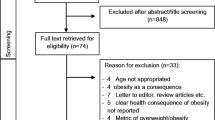Abstract
The goal of the this study was to track and assess children’s health status in Nevada and build relationships between researchers and school districts through the collection of mutually beneficial health data at a local level. All elementary schools in Nevada were sent a health survey for parents of kindergarten students to complete. A total of 3,628 surveys were received with usable height and weight needed to calculate Body Mass Index (BMI). African American and Hispanic children had significantly higher BMI scores compared to Caucasian and Asian/Pacific Islander children, regardless of income. Children who had diabetes or mental health concerns also had significantly higher mean BMIs compared to children without these health concerns. Overall staff within the school districts felt that this surveillance system should be continued as data from this study provided important information subsequently used to guide programming and when applying for grants. Our children’s welfare depends on community collaboration to create and implement data-driven initiatives to combat childhood obesity.

Similar content being viewed by others
References
Dishman, R. K., Washburn, R. A., & Heath, G. (2004). Physical activity epidemiology (p. 30). United States: Human Kinetics Publishers.
Centers for Disease Control and Prevention (2009). Defining overweight and obesity. Atlanta, GA: Centers for Disease Control and Prevention. http://www.cdc.gov/nccdphp/dnpa/obesity/childhood/defining.htm. Accessed April 1, 2009.
United States Department of Health and Human Services (2007). The surgeon general’s call to action to prevent and decrease overweight and obesity. Web site. http://www.surgeongeneral.gov/topics/obesity/calltoaction/fact_adolescents.htm. Accessed January 15, 2009.
Centers for Disease Control and Prevention (2006). Overweight and obesity home. Atlanta, GA: Centers for Disease Control and Prevention. http://www.cdc.gov/nccdphp/dnpa/obesity/. Accessed February 4, 2009.
Lee, W., DeJan, E., Yang, W., Wright, J., Huth, C (2005). Nevada 5 year maternal and child health needs assessment report 2006-2010. Carson City, NV: Bureau of Family Health Services and Bureau of Health Planning and Statistics. http://health2k.state.nv.us/BFHS/MCHneedsassessmentreport20062010.pdf. Accessed February 4, 2007.
Polhamus B, Dalenius K, Borland E, Smith B, Grummer-Strawn L. (2007) Pediatric nutrition surveillance 2006 report. Centers for Disease Control and Prevention. http://www.cdc.gov/pednss/pdfs/PedNSS_2006.pdf. Accessed May 11, 2009.
Harwell, M. R., Rubinstein, E. N., Hayes, W. S., & Olds, C. C. (1992). Summarizing monte carlo results in methodological research: the one- and two-factor fixed effects ANOVA cases. Journal of educational statistics, 17, 315–339.
Hoelscher, D. M., Day, R. S., Lee, E. S., Frankowski, R. F., Keider, S. H., Ward, J. L., et al. (2004). Measuring the prevalence of overweight in Texas schoolchildren. American Journal of Public Health, 94, 1002–1008.
Kumanyika, S. (2002). The minority factor in the obesity epidemic. Ethnicity and Disease, 12, 316–319.
Delva, J., Johnston, L. D., & O’Malley, P. M. (2007). The epidemiology of overweight and related lifestyle behaviors: racial/ethnic and socioeconomic status differences among American youth. American Journal of Preventive Medicine, 33, S178–S186.
Jain, A., Sherman, S. N., Chamberlin, L. A., Carter, Y., Powers, S. W., & Whitaker, R. C. (2001). Why don’t low-income mothers worry about their preschoolers being overweight? Pediatrics, 107, 1138–1146.
Kumanyika, S., & Grier, S. (2006). Targeting interventions for ethnic minority and low-income populations. The Future of Children, 16, 187–207.
Narayan, K. M., Boyle, J. P., Thompson, T. J., Sorensen, S. W., & Williamson, D. F. (2003). Lifetime risk for diabetes mellitus in the United States. JAMA : The Journal Of The American Medical Association, 290, 1884–1890.
Rosenbloom, A. L. (2002). Increasing incidence of Type II Diabetes in children and adolescents: treatment considerations. Paediatric Drugs, 4, 209–221.
Rosenbloom, A. L., Arslanian, S., Brink, S., Conschafter, K., Jones, K. L., Klingensmith, G., et al. (2000). Type II Diabetes in children and adolescents. Diabetes Care, 23, 381–389.
Caprio, S. (2007). Treating child obesity and associated medical condition. The Future of Children, 16, 209–220.
Schwartz, M. B., & Puhl, R. (2003). Childhood obesity: A societal problem to solve. Obesity Reviews, 4, 57–71.
Doolen, J., Alpert, P. T., & Miller, S. K. (2009). Parental disconnect between perceived and actual weight status of children: a metasynthesis of the current research. Journal of the American Academy of Nurse Practitioners, 21, 160–166. Review.
Taras, H., & Potts-Datema, W. (2005). Chronic health conditions and student performance at school. The Journal of School Health, 75, 255–266.
Acknowledgments
We would like to acknowledge the Southern Nevada Health District and the Clark County School District for approaching the Nevada Institute for Children’s Research and Policy to conduct this study. We would also like to acknowledge the Nevada State Health Division for implementing the project statewide and for providing all printed materials.
Author information
Authors and Affiliations
Corresponding author
Appendix
Appendix


Rights and permissions
About this article
Cite this article
Haboush, A., Phebus, T., Tanata Ashby, D. et al. Still Unhealthy 2009: Building Community Research to Identify Risk Factors and Health Outcomes in Childhood Obesity. J Community Health 36, 111–120 (2011). https://doi.org/10.1007/s10900-010-9288-8
Published:
Issue Date:
DOI: https://doi.org/10.1007/s10900-010-9288-8




